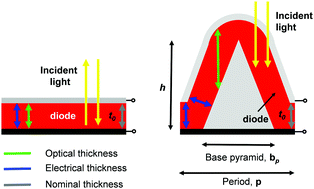Enhancing the energy conversion efficiency of low mobility solar cells by a 3D device architecture†
Abstract
Solar cells based on semiconductor materials with low diffusion lengths like organics and amorphous silicon exhibit short circuit currents and energy conversion efficiencies distinctly below the detailed balance limit (commonly called the Shockley Queisser limit). The short circuit current and energy conversion efficiency of such solar cells can be increased by employing a 3D device architecture. The 3D device architecture leads to a distinct gain in the optical thickness of such solar cells compared to a conventional planar solar cell, while the electrical thickness of the investigated 3D and planar solar cells is equal. Hence a short circuit current can be achieved close to the theoretical upper limit. In this study, a 3D organic solar cell is studied. The influence of the 3D architecture on the solar cell performance parameters of a small molecule organic solar cell was investigated. Finite-difference time-domain optical simulations are utilized to determine the quantum efficiency and short circuit current of the 3D solar cell structure. A guideline is provided on how to achieve a high energy conversion efficiency with a 3D solar cell. The proposed approach is not only applicable to organic solar cells. The approach is applicable to all solar energy materials with low diffusion length and/or low charge carrier mobility.

- This article is part of the themed collection: Journal of Materials Chemistry C Advisory Board Collection


 Please wait while we load your content...
Please wait while we load your content...